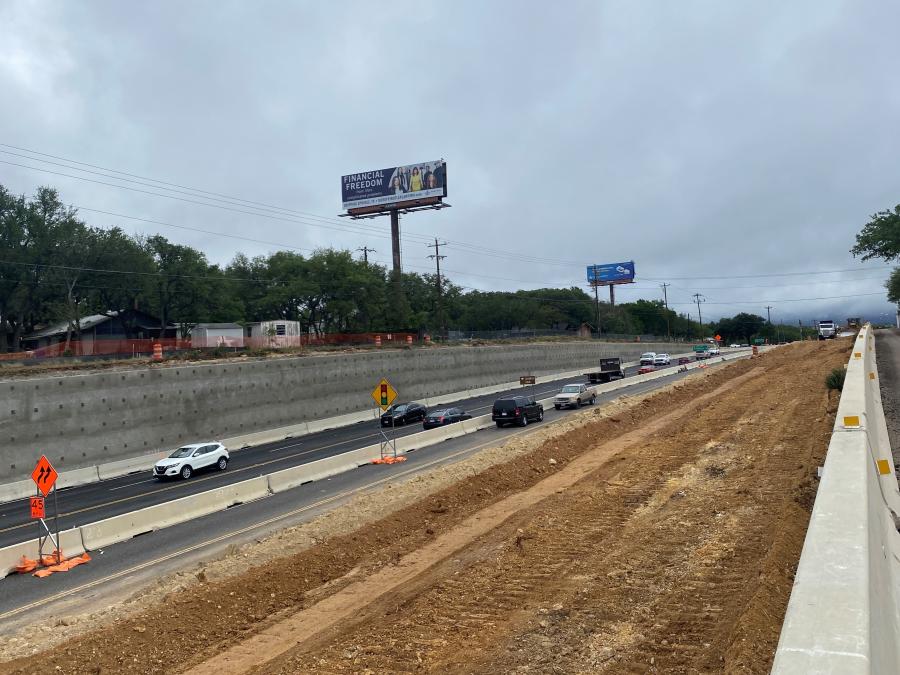Oak Hill Parkway workers install the first bridge beams for the project along U.S. 290 at Old Fredericksburg Road. This is one of several existing bridge widenings taking place east of the U.S. 290/
SH 71 Y interchange.
(Colorado River Constructors photo)
According to the U.S. Census estimates, Austin showed one of the largest population gains of any metro area in the United States. The city grew by more than 53,000 people in a single year, representing the fourth largest increase in the country.
More people mean more jobs, more shopping and, of course, more traffic. A recent project, some 30 years in the making, aims to take a bite out of that traffic in one historically congested area.
At a cost of $674 million, the joint venture of Fluor and Balfour Beatty Infrastructure — Colorado River Constructors — (overseen by the Texas Department of Transportation) plans to inject new life and beauty in a busy area.
For years locals and commuters alike have tried to avoid the U.S. 290 intersection with SH 71 because of congestion. The project is scheduled for completion in 2026 and will eliminate almost all traffic lights, allowing for free-flowing traffic through a residential area.
One highlight of the project, decided upon with heavy local input, is to put the 290 mainlanes in the "basement," allowing connecting roads to be at grade. Flyovers will be less overpowering visually, contrasting with other busy Texas roadways where one highway is stacked on top of another in a concrete stairway to heaven.
Here are some of the highlights of the project:
- Upgraded roadway consisting of two-to-three non-stop U.S. 290 mainlanes for through traffic in each direction. Frontage road lanes also will be built in each direction;
- U.S. 290 mainlanes overpass over William Cannon Drive along with new flyovers between U.S. 290 and SH 71;
- U.S. 290 main lanes will be lowered under SH 71;
- New intersections will be constructed along U.S. 290 at Convict Hill Road, RM 1826, Scenic Brook Drive and Circle Drive where the highway will go below the existing ground level with the cross street at ground level;
- U-turns will be constructed at intersections along U.S. 290 and SH 71 to allow vehicles traveling on frontage roads to access the opposite direction frontage road;
- Flyover ramps on SH 71 will extend past Scenic Brook Drive where the mainlanes will transition to a five-lane highway with U-turns for local access;
- Significant bicycle and pedestrian accommodations will be built along the entire corridor, including 14 mi. of shared-use path and 1.5 mi. of sidewalks; and
- Multiple water quality treatment ponds will be built within the corridor.
Joint Venture
Colorado River Constructors (CRC) has completed several infrastructure projects over the last 20 years in the Austin area.
The job is a design-build project. CRC took over after 30 percent of the design work had been completed by TxDOT. At the end of 2021, the design was complete; the excavation and utility relocation began July 2021. Overall, the remaining aspects of the project are expected to be complete by the first quarter of 2026.
The first phase of the project is for CRC to build frontage roads outside of the current footprint of U.S. 290. Once the frontage roads are built, traffic from U.S. 290 can be shifted over onto these asphalt roads and construction of the concrete mainlanes can commence.
CRC expects to use 250,000 tons of asphalt, 300,000 cu. yds. of concrete and excavate approximately 2 million tons of material. Much of this is done to create the massive trenches where the mainlanes of U.S. 290 will flow. Approximately 20 percent of the excavation is finished.
"We will be excavating for future water and sewer pipelines at the same time we are doing excavating for the 290 lanes," said David Trent, CRC construction manager of the project. "What we are excavating is mostly rock, so it's a big job. We are using H.L. Chapman as our subcontractor providing rock trenchers that dig a 25-foot-deep trench that is four feet wide."
Some of the excavated rock will stay at the project.
"The rock and the original road will be crushed to create a cement treated base [CTB] that will serve as a solid subgrade for the new road that is being built," Trent said.
Along with digging the massive trenches, CRC has been working with utility companies to relocate water and sewer lines.
"This can be a tedious process, but we are making sure to do it correctly," said Trent. "This is especially important since we are operating over the Edwards Aquifer, a main water supply for San Antonio, which is about 80 miles away. We studied the area before excavating and pre-drilled holes and sent cameras below the surface to make sure we would not be harming that important water supply."
One daunting piece of the project will be the 27 bridges that will be restructured. Work on seven of the bridges has already begun. Of course, some lanes of traffic will need to be shut down or redirected while work on bridges and flyovers is done.
A unique part of the project concerns the tree preservation plan. Several iconic oak trees in the areas of U.S. 290 and William Cannon Drive will be preserved. TxDOT identified tree preservation areas in addition to the iconic oaks. CRC identified more than 200 other trees that can be saved along the alignment due to design optimization. CRC also will be planting hundreds of new trees in the area — choosing species that hold historical and ecological value to the area.
Tech Presence
Large construction projects like this use heavy machinery that dig through rock, pave new roads and lift heavy bridge elements into place. This project also used nearly invisible elements to make the workers more knowledgeable, safer and more efficient.
"A special app will enable work crews to submit end-of-day safety signatures, fill out safety task assignment form, find safety topics for ‘toolbox talks' and record daily safety observations both positive and negative," Trent said.
Trent also noted that workers can access iPads outfitted with Autodesk's Build program in the field.
"This innovative technology will provide workers with the latest approved construction plans, eliminating the need for paper copies in the field," Trent said. "It allows files to combined and submitted digitally."
CRC is using drones to track construction progress as well as quantify earthwork volumes during excavation. A program called DroneDeploy will allow CRC to create a 3D topographical map of the project, with the software overlaying new information from weekly flights to calculate needed changes.
In addition to the heavy lifting work that will include building giant trenches and new asphalt and concrete roads, CRC and TxDOT will create some add-ons that will enhance the residential communities around Oak Hill Parkway. Prior to this work, there were few sidewalks. Bicyclers and walkers had to move carefully beside four busy lanes of traffic.
"One aspect of the project will be to build a 12-foot wide concrete shared-use path," said Trent. "This path will continue for 14 miles and I'm sure will be heavily used by people in the community."
This is Trent's fourth major joint venture task. His experience gives him some perspective of the potential outcome for this mammoth job.
"People have been avoiding this area for 30 years because of the congestion," he said. "I think motorists will be pleasantly surprised when they find they can go through U.S. 290 for five miles without having to stop for traffic lights." CEG
Chuck MacDonald
Chuck MacDonald is an editor, blogger and freelance feature writer whose writing adventures have taken him to 48 states and 10 countries. He has been the editor for magazines on pavement construction, chemicals, insurance and missions. Chuck enjoys bicycling, kayaking and reading. He graduated from the University of Missouri with a degree in journalism. Chuck lives in Annapolis, Md. with his wife Kristen. They have seven grandchildren.
Read more from Chuck MacDonald here.
Today's top stories




















